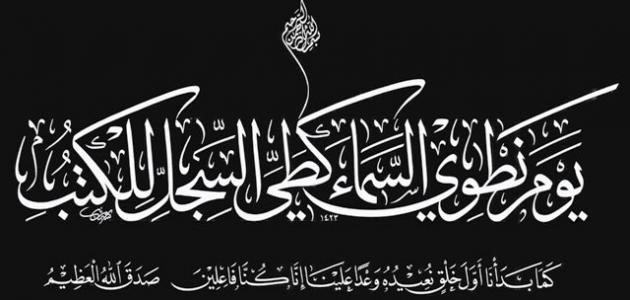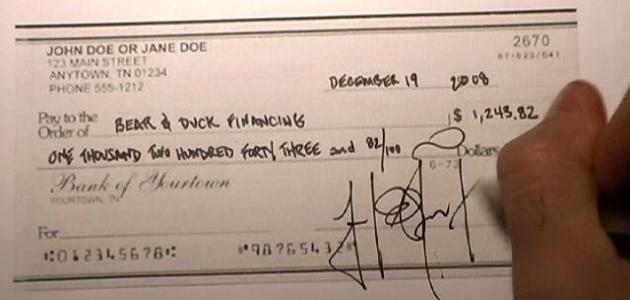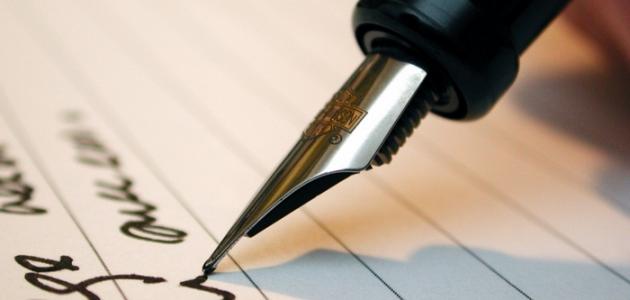Font definition
Calligraphy is known by many different terms and definitions. It is called drawings and shapes that indicate the audible words that indicate the needs and feelings of the soul. It is a faculty by which the movement of the fingers with the pen is controlled on the basis of certain rules and controls. Calligraphy was defined as the art of drawing letters in a beautiful and attractive way, and it is the best and most comprehensive definition of calligraphy.
The origins of Arabic calligraphy and writing
Arabic calligraphy has a high artistic value and a distinguished history. The art of calligraphy is associated with Arabic decoration, as it is used to decorate the domes of mosques and the walls of palaces. It is also used to decorate ancient manuscripts and books, in addition to being used in particular in copying the Holy Qur’an. The Arabs have known calligraphy as the tongue of the hand, and it is considered The art of calligraphy is one of the most delicious and beautiful arts. Arabic calligraphy adds a special beauty and elegance to the aesthetics of painted paintings, Quranic verses, and Prophetic hadiths.
The history of Arabic calligraphy extends back a long time, and there are many historical novels and theories that discuss and present ideas regarding the emergence of Arabic calligraphy and writing. Among these novels and theories are the following:
- The first theoryWhich says that the source of writing is divine, from God Almighty, and this theory is based on the Qur’anic verse: (And He taught Adam all the names, then presented them to the angels and said, “Inform Me of the names of these, if you are truthful.”); That is, Adam, peace be upon him, was the one who placed the writings on the earth after God Almighty taught them to him, and after the great flood that flooded the earth, every nation got its own writing.
- The second theorySupporters of this theory believe that the Arabic script was derived from the Musnad script known as the Himyarite script because of the central geographic location of the Arabian Peninsula, which is located between Yemen, the Levant and Iraq, as commercial convoys frequently passed through it, so the Arabs took the Himyarite script from them and derived the Arabic script from it. They called it the Jazm script, meaning the one derived from the Musnad.
- The third theoryThe basis of this theory is that the Arabic script evolved from the Nabataean script, and this theory is based on the study of inscriptions dating back to the pre-Islamic era and the first century AH, and this is evidenced by the inscriptions found in Umm al-Jimal in Jordan.
- The Arabic language was written without dots at its beginning, and this situation continued until Abu Al-Aswad Al-Du'ali came and put dots on the letters. In the past, the name (Khaled) was written in Arabic, for example, like this (Haled) until Abu Al-Aswad came and made it (Khaled); To distinguish between words that might be similar in the absence of dots.
Types of Arabic fonts
There are many Arabic fonts that differ in origin, reason for naming, and uses as well. The types of Arabic fonts are:
Read also:Summer theme essay- koufi fontThis script took its name from the city of Kufa in Iraq, where it appeared for the first time. The Kufic script was derived from the Nabataean script, which was widespread in the Arabian Peninsula, and the Qur’ans were written with it for five centuries until the fifth century AH. The letters of the Kufic script are characterized by straightness, and must be Use a ruler to write letters lengthwise and widthwise. The Kufic script spread and became very famous in the Abbasid era in particular. It was used to write all correspondence, documents, and decorate mosques and various buildings. The Qur’an was written on parchment until the ninth century AD. Kufic script has many types, more than 70 types. The closeness in drawing letters and forming words is clearly defined in the Kufic script.
- Naskh lineIt is one of the clearest Arabic fonts ever, and it was very famous in the ancient Abbasid era. It is distinguished by its ease and clarity of letters and movements. It is currently used very widely in copying the Qur’an, newspapers, magazines, and educational and study books written in the Arabic language. The first one to establish the rules of the Naskh script was the minister Ibn Muqla, and it was the Atabeg script, so it was known as the Atabeg Naskh script.
- The third lineIbn Muqla laid down the foundations and rules of this calligraphy, including its scales and dimensions, and then after him came Ibn al-Bawab al-Baghdadi, who refined it and mastered its composition without interfering with the foundations and rules of the calligraphy. The Thuluth calligraphy is considered one of the most magnificent in appearance and beauty, and the most difficult to write and master. The Thuluth calligraphy has developed over time in a great way. It became great until it reached its current form, and the ability to master writing in Thuluth script is considered the main standard and criterion for measuring the talent and ability of calligraphers and distinguishing between them.
- Line vampIt is the usual script that people use to write on a daily and regular basis. The origin of its innovation goes back to the Turks, specifically the Turkish calligrapher Mumtaz Bey. It was created in the offices of the Ottoman Caliphate to be the approved script in the correspondence of employees of the Ottoman Empire. In addition, it is considered the regular script in daily writings and correspondence, and it is the origin of the scripts. Arabic is the simplest, and it has well-known styles, including Turkish, Egyptian, or commercial. It is also considered by calligraphy teachers to be the first script for the learner. The Ruq'a font is used in newspapers, magazines, and banners, and the Ruq'a font is distinguished by not deriving other fonts from it.
- Diwani calligraphyIt is considered one of the most beautiful Arabic calligraphy, and it was called Diwani because calligraphers adopted it in the offices of kings and caliphs. Diwani calligraphy is distinguished by the straightness of its lines from the bottom, and does not contain any movements. This calligraphy was discovered during the reign of the Ottoman Sultan Mehmed the Conqueror, and other types of calligraphy were created from the Diwani calligraphy, such as the interconnected Diwani calligraphy, the clear Diwani calligraphy, the woven Diwani calligraphy, the Hamayouni calligraphy, and the clear Diwani script.
- Persian scriptPersian calligraphy appeared in Persia (Iran) in the thirteenth century AD. Persian calligraphy is distinguished by its ease, clarity, simplicity, lack of complexity, and does not contain vowels. The Persians began using this script after the spread of Islam. The rules and foundations of this script were set by the Persian calligrapher Mir Ali Tabrizi, and with the increasing and great interest in the Persian script, other types of scripts were derived and discovered from the Persian script, including the Shuksta script, the symmetrical Persian script, and the shortened Persian script. .
- Leave lineThis script is considered a combination of the Naskh script and the Thuluth script, as they are the origin of the Ijaza script. It was given this name because the calligrapher bypassed combining them. This calligraphy was invented and its foundations were laid by the calligrapher Yusuf Al-Shajri. It was refined and developed after him by the calligrapher Mir Ali Al-Tabrizi, and its uses are similar to the uses of the Thuluth script.
- Tughra lineIt is a beautiful form of Arabic calligraphy that is shaped like a coffee pot, and is often written in thuluth script. The Ottoman sultans were the ones who specialized in using it to a very large extent. This script disappeared with the disappearance of the Ottoman Empire, but its use still exists in a very small way, and it is written with it. Calligraphers usually use the Qur’anic Basmalah and the noble Prophetic hadiths in order to preserve it.
- Crown line: It is a developed version of the Thuluth script, and the reason for its development was the Egyptian King Fouad I, who instructed the development of this script, and the first letter in this script is in the shape of a crown, but it did not spread much, and was not used much except during the period of its development and discovery only.
- Moroccan calligraphyThe reason for its name is that the calligraphers of Egypt and the Levant did not approve of it, and it remained used as a local script in Morocco. This script developed greatly after the prosperous period of Andalusia in the eighth and ninth centuries AH, then interest in this script declined and the area in which its use spread decreased.
Arabic calligraphy in the modern era
It is known that Arabic calligraphy has not reached what it is now in the current era, but rather has evolved over time to reach this stage of development, sophistication and beauty, and in the current era there are many people who are interested in it and seek to develop and master it, and as an example of the rediscovered calligraphy Or its development in the modern era, calligraphy and drawing with words; Ghobari calligraphy is a calligraphy related to Sufism, and it was called Ghobari because of its accuracy and smallness, and drawing with words is an art that combines Arabic calligraphy and drawing with graphic designs, where the painting contains shapes drawn with graphics and other additions drawn with words written in Arabic calligraphy. There are many museums concerned with Arabic calligraphy, such as the Arabic Calligraphy Museum in Damascus, and the Emirates Arabic Calligraphy Museum.
Read also:Subject matter of science and ethics








